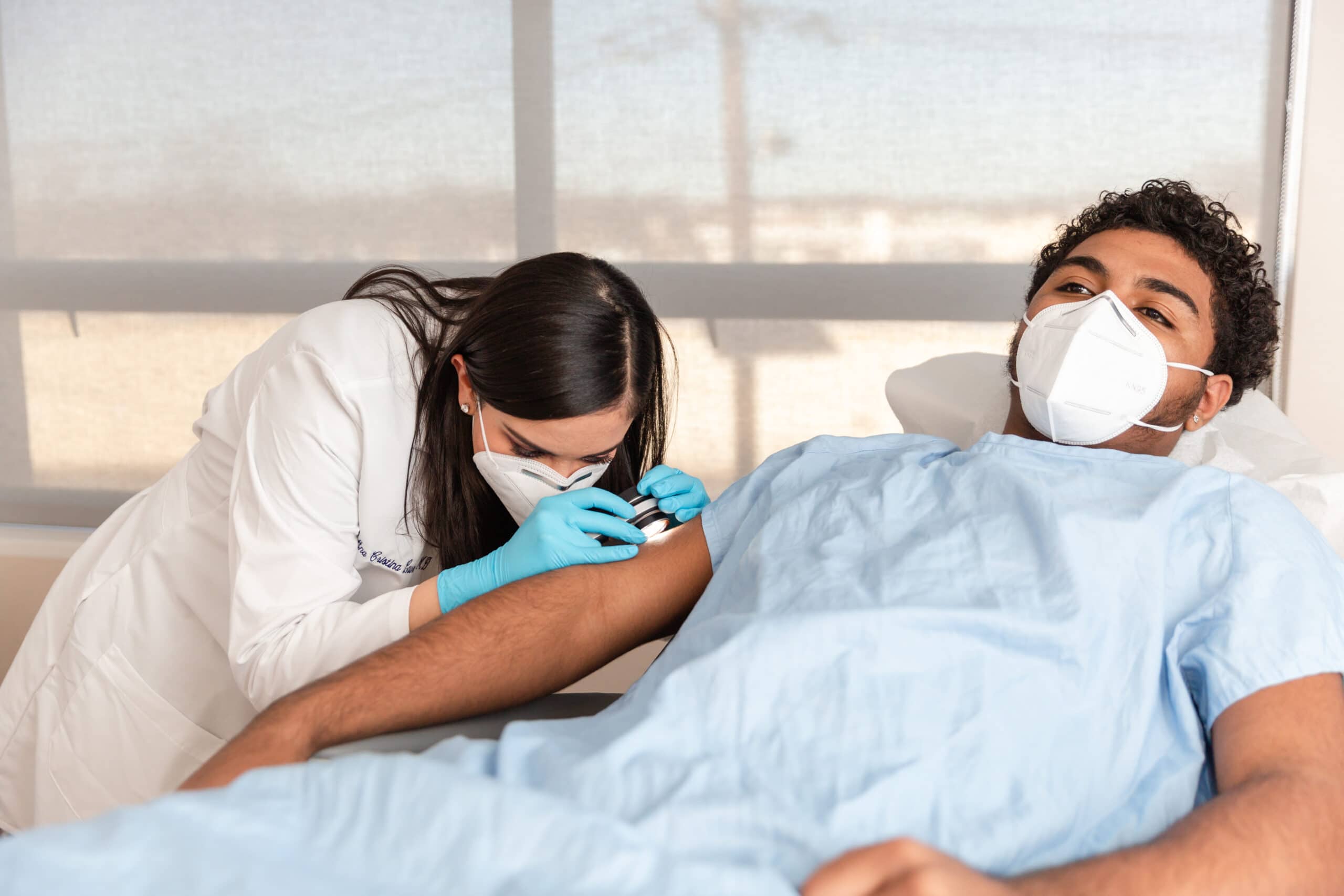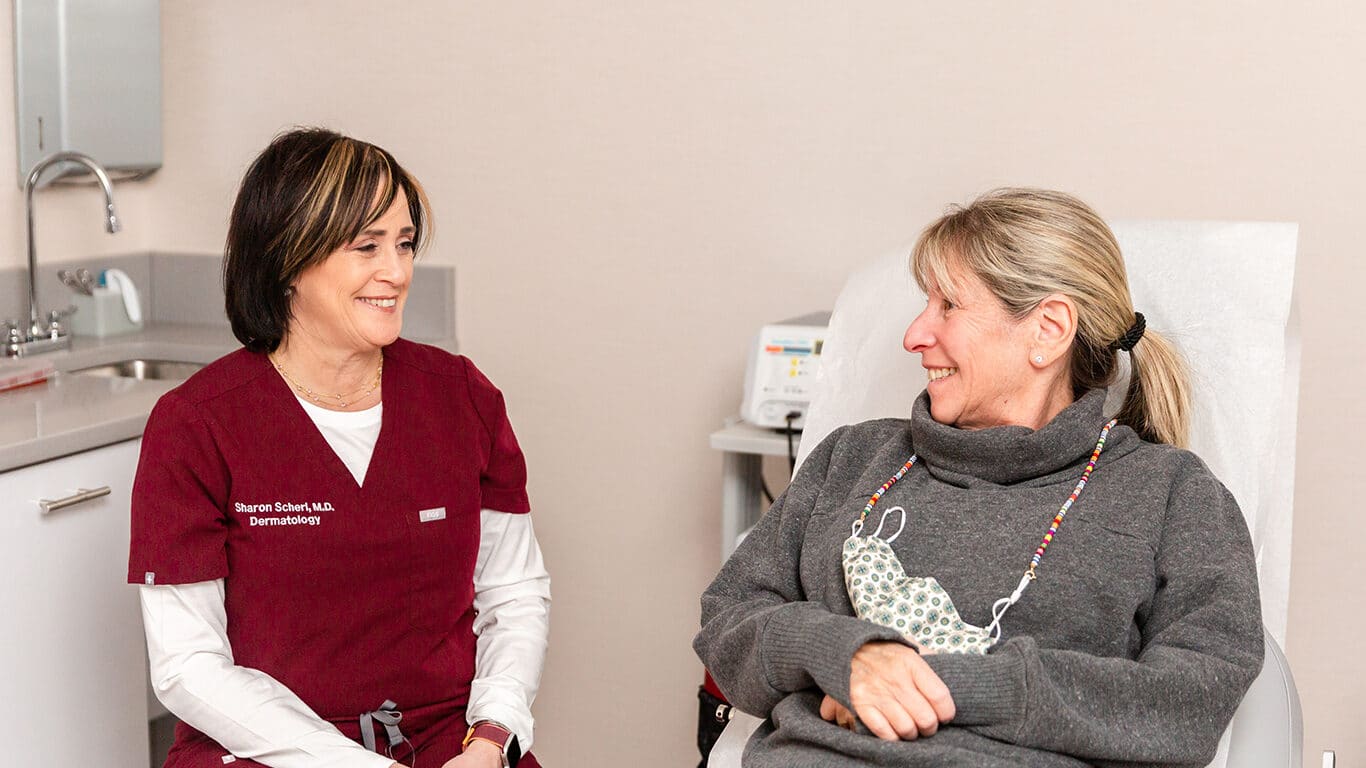
Skin Conditions
At SSMD we partner with you for beautiful, healthy skin. A big part of that health partnership is education, so we have created this area to help you learn about a variety of skin conditions. However, this information is not a substitute for a dermatologist’s care or medical advice.
Skin Conditions
Acne
Acne is the most common skin condition in the United States. Although it’s common, accurate information about acne can be scarce.
Acne Cysts
An acne cyst forms when the pore fills with dead skin cells oil, and bacteria. A cyst goes deep into the skin and can hurt.
Actinic Keratosis
An actinic keratosis or AK is a rough, dry, scaly patch or growth that forms on the skin. An AK forms when the skin is badly damaged by ultraviolet (UV) rays from the sun or indoor tanning.
Alopecia (Hair Loss)
Millions of people experience hair loss. Some people see their hair re-grow without doing anything. Others need treatment for their hair to re-grow. Sometimes, hair will not re-grow.
Atopic Dermatitis/Eczema
This is a common skin disease in children. Children often get atopic dermatitis (AD) during their first year of life. If a child gets AD during this time, dry and scaly patches appear on the skin.
Atypical Mole (Dysplastic)
This type of mole can look like melanoma. It is not melanoma. But you have a higher risk of getting melanoma if you have certain risk factors.
Barnacles
Barnacles are a very common benign growth. See your dermatologist if you are concerned, because skin cancer can sometimes look similar to a seborrheic keratosis to an untrained eye.
Basal Cell Carcinoma
Basal cell carcinoma (BCC) is the most common form of skin cancer. More than two million cases of this skin cancer are diagnosed in the United States each year.
Bed Bugs
Bedbugs are tiny insects that feed on human blood. They hide in dark places close to where humans sleep and usually crawl out to feed while people are fast asleep.
Dry Skin
Dry skin is common. It can occur at any age and for many reasons. Using a moisturizer often helps repair dry skin.
Eczema
Eczema is an uncomfortable skin condition that impacts patients of every age. While the exact cause of eczema isn’t known, scientists believe the immune system may play a role.
Fungal Infections
Fungi are single or multi-cellular organisms that cause skin infections. Fungi can be true pathogens, which cause infections in healthy people, or opportunistic pathogens, which cause infections in immune-compromised patients.
Gential Warts
Genital warts are warts that appear in the genital area. There can be 1 wart or a cluster of warts. People get these warts by picking up the human papillomavirus (HPV) from someone who is already infected with this virus.
Herpes Simplex
Herpes simplex is a common viral infection. If you’ve ever had a cold sore or fever blister, you picked up the herpes simplex virus.
Hives
Hives are welts on the skin that often itch. These welts can appear on any part of the skin. Hives vary in size from as small as a pen tip to as large as a dinner plate. They may connect to form even larger welts.
Lichen Planus
Many people get lichen (LY-kin) planus (PLAN-us). This disease can develop on one or several parts of the body. It can appear on the skin or inside the mouth.
Melasma
Melasma (muh-LAZ-muh) is a common skin problem. It causes brown to gray-brown patches on the face.
Mohs Surgery
Mohs surgery is the most effective treatment for certain types of skin cancer. Skin cancer is the most common type of cancer in the United States and around the world. While dangerous, skin cancer is treatable with early detection.
Moles
It is usually quite easy to remove moles surgically. Usually there is a trade involved – removing the mole in exchange for a small scar. If the mole is large and the scar will be less noticeable, then it is a good trade.
Molluscum Contagiosum
Molluscum (muh-luhs-kum) contagiosum (kən-tā-jē-ō-səm) is a common skin disease. It is caused by a virus. This virus easily spreads from person to person. People can get molluscum by sharing towels and clothing.
Nummular Dermatitis
People who get this skin problem often see distinct, coin-shaped (nummular) or oval sores on their skin. Nummular dermatitis often appears after a skin injury, such as a burn, abrasion (from friction), or insect bite.
Photodynamic Therapy
Photodynamic Therapy (PDT) is a medical treatment that involves two steps: the use of a light-sensitive drug and the application of a light source to destroy abnormal cells.
Phototherapy
The narrowband phototherapy lightbox is Scherl Dermatology’s latest innovative treatment. Carefully controlled, it is an extremely effective tool for treating inflammatory skin conditions such as psoriasis and eczema.
Pityriasis Rosea
People of all ages and skin colors get pityriasis rosacea, but this skin disease is more likely to occur between 10 and 35 years of age and during pregnancy.
Poison Ivy Dermatitis
Many people get a rash from poison ivy, poison oak, and poison sumac. This rash is caused by an oil found in the plants.
Psoriasis
Psoriasis is a common inflammatory skin disease characterized by itchy or sore patches of various sizes. Often theses patches of skin have, silvery scales.
Rash
“Rash” is a general term for a wide variety of skin conditions. A rash refers to a change that affects the skin and may appear as a red patch, small bumps or blisters on the skin.
Rosacea
Many people suffer from rosacea. It is not contagious, but there is some evidence to suggest that it is inherited. There is no known cause or cure for rosacea.
Seborrheic Dermatitis
Seborrheic dermatitis can look like psoriasis, eczema, or a skin allergy.
Seborrheic Keratosis
In most people, seborrheic keratoses first appear in middle age or later. People who are most likely to get these growths have family members with seborrheic keratoses.
Shingles/Herpes Zoster
Anyone who has had chickenpox can get shingles. After the chickenpox clears, the virus stays in the body. If the virus reactivates (wakes up), the result is shingles — a painful, blistering rash.
Skin Growths
There are multiple types of bumps and growths that can appear on the skin, including: Small, hard, white bumps (milia) and Enlarged oil glands (sebaceous hyperplasia).
Skin Cancer
Even the same type of skin cancer can look very different from person to person. This makes it hard to look at a picture and tell if you have skin cancer.
Tinea Versicolor
We all have yeast living on our skin. When the yeast grow out of control, a person can get a skin disease called tinea versicolor.
Warts
Warts (Verrucae) are common growths that are caused by the Human Papilloma Virus (HPV). These can commonly involve the fingers, hands, feet, while certain strains can cause genital warts.
Thousands of People in the Metro Area Trust Scherl Dermatology
CONTACT US
Scherl Dermatology
Englewood Cliffs, NJ 07632
Same-Day Appointments Now Available


CONTACT US
Scherl Dermatology
140 Sylvan Ave. Suite 302,
Englewood Cliffs, NJ 07632
Same-Day Appointments Now Available
Scherl Dermatology
©2024 Schweiger Dermatology Group. All Rights Reserved. Privacy Policy | The information available on this website is provided for informational purposes only. This information is not intended to replace a medical consultation where a physician's judgment may advise you about specific disorders, conditions and or treatment options. We hope the information will be useful for you to become more educated about your healthcare decisions. If you are vision-impaired or have some other impairment covered by the Americans with Disabilities Act or a similar law, and you wish to discuss potential accommodations related to using this website, please contact us at 201.568.8400 .

